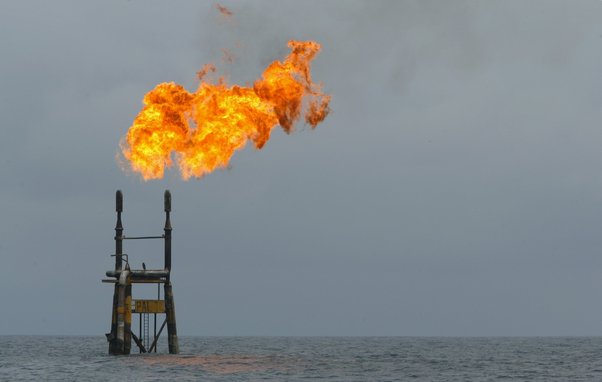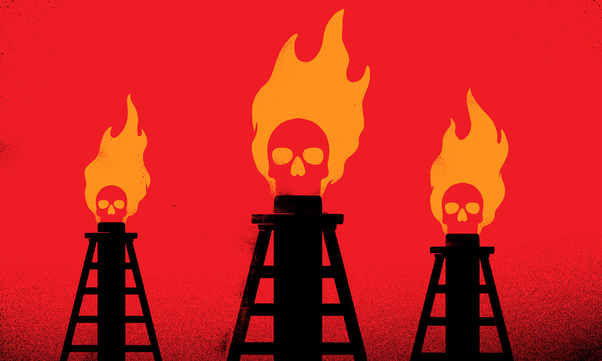The global oil and gas industry saw historic gains from the fallout of the war in Ukraine, a global energy crisis and runaway climate change, as millions suffer the consequences
2022 was a brutal year. Putin’s invasion of Ukraine killed more than 7,000 civilians and displaced at least 14 million Ukrainians. The war brought turmoil to already strained global energy and food markets, forcing up to 95 million people into extreme poverty.
Meanwhile, greenhouse gas emissions continued to rise and extreme heatwaves, droughts and floods destroyed livelihoods across the globe. Historic floods in Pakistan alone killed more than 1,730 people and affected at least 33 million lives.
It is no coincidence that the brutality of 2022 was a bonanza for the oil and gas industry.
At the heart of the industry’s exorbitant profit lies the world’s first truly global energy crisis. Sparked by Russia’s invasion of Ukraine, it made already high wholesale gas prices skyrocket, driving historic gains for oil and gas producers.
So much so, that 2022 saw US President Biden accuse the industry of “war profiteering” while UN Secretary General Guterres warned that the companies “have humanity by the throat.”
2022 saw record profits for all five Western oil and gas majors
Global Witness assessed the 2022 annual profits of the five largest integrated private sector oil and gas companies – Chevron, ExxonMobil, Shell, BP and TotalEnergies.
Together, their total profits add up to $195 billion in 2022, nearly 120% more than the previous year, and the highest level in the industry’s history.
ExxonMobil led the pack, reporting an annual net income of $56 billion. That is the highest amount in its 152-year history and almost 1.5 times as much as in 2021.
Excess profits for Exxon & Co
People are not blind to the link between the huge amounts of money the oil and gas industry has been making and the global energy affordability crisis.
Across Europe and North America, public pressure has mounted to introduce windfall taxes that would redirect the industry’s excess profits in order to protect households and businesses against the price shock.
Excess profits, or windfall profits, are sudden and significant increases in a company’s financial returns that are due not to their own actions but to external events – such as the war in Ukraine. They are the money on which windfall taxes can be levied.
So, how much excess profit have ExxonMobil, Shell and their peers made in 2022?
Global Witness assessed the financial returns of the five largest Western oil and gas companies. Our method mirrors the European Union’s approach – profits count as excess profits if they are more than 20% above the average return of the previous four years (2018-2021).
The result: in 2022, Chevron, ExxonMobil, Shell, BP and TotalEnergies made $134 billion in excess profits, predominantly due to the effects of the war in Ukraine.
The highest beneficiary, ExxonMobil alone makes up $45 billion of this sum.
Western majors gained more than $130 billion in 2022 excess profits
What $134 billion could do
The three defining crises of 2022 were linked to our dependency on fossil fuels – the global cost-of-living crisis, the war in Ukraine and climate breakdown. Instead of enriching a handful of wealthy companies and their shareholders, excess oil and gas profits could be spent on containing the fall-out from these crises.
For instance, governments across Europe are spending billions to try and shield households and businesses from the energy crisis that filled the fossil fuel industry’s coffers.
Based on figures published by the thinktank Bruegel, Chevron’s $27 billion in excess profit would suffice to cover these costs for Bulgaria, Croatia, Romania, Czechia, Latvia, Slovenia and Estonia combined.
As Putin’s fossil fuel-funded war continues to drive a humanitarian catastrophe in Ukraine, only one-fifth of TotalEnergies’ $22 billion in excess profits would have been enough to cover the entire $4.3 billion requested by the United Nations last year to provide humanitarian relief to all Ukrainians in need.
And, of course, 2022 saw the world struggle to adapt to rapidly escalating climatic shocks. BP could pick up Pakistan’s $14.9 billion in flood damages and still have $3.8 billion in excess profits left. On top of $9 billion in regular profits.
The five companies’ joint $134 billion in annual excess profits could cover nearly 20% of the money all European governments together allocated to shielding vulnerable households and businesses from the energy crisis.
The sum would also be enough to stem nearly 40% of Ukraine’s required funds to reconstruct and recover the entire country from the war, which the World Bank estimates will costs $349 billion.
And, perhaps the most appropriate comparator given that the oil and gas industry is a primary driver of climate change: their $134 billion excess could cover four-fifths of the $168 billion in damages caused by the 10 worst climate-fuelled extreme weather events in 2022.

A feast for shareholders
Contrary to the oil and gas industry’s rhetoric about tackling climate change and transitioning their business models, its excess profits predominantly benefit their shareholders.
Together, the five oil and gas giants returned $102 billion in profits to benefit their investors. Paying out $48 billion in dividends and spending $54 billion to repurchase shares – a common yet controversial approach to increasing shareholder value.
President Biden, for instance, publicly urged the companies to stop passing their crisis-driven windfall onto shareholders rather than consumers “while a war is raging” and “families are hurting” under record energy prices.
Seemingly unperturbed, Chevron celebrated their 2022 record profit, saying “we delivered on our financial priorities: returning cash to shareholders, investing capital efficiently, and paying down debt.”
Unsurprisingly, the industry’s green rhetoric is more talk than walk. The International Energy Agency (IEA) projects that investments in clean energy projects will only make up about 5% of the oil and gas sector’s capital investments in upstream energy production in 2022. That leaves 95% of investments for traditional oil and gas extraction.
And Shell, for instance, appears to have inflated its spending on renewables by counting some fossil gas activities towards a segment labelled “renewables and energy solutions”. Global Witness has filed a greenwashing complaint calling on the US authorities to investigate whether Shell has misled investors in violation of US law.
What the IEA calls “a once-in-a-generation opportunity … for major oil and gas companies to deliver more diversified spending” – is being missed.
Political access guaranteed?
While the crisis has deepened the gulf between profiteering polluters and a cash-strapped public, the relationship between policymakers and the fossil fuel industry appears to have grown ever closer.
In September 2022, a Global Witness investigation revealed that within weeks of Russia’s attack on Ukraine, US President Biden had implemented all of the policy requests issued by a secretive fossil fuel lobby group as a supposed response to the war.
In October 2022, a report by the Fossil Free Politics Campaign found that European Commission leaders met more than 100 times with the fossil fuel industry since the war started, gaining “an even stronger role than before in EU decision-making on energy.”
And in November 2022, Global Witness and partners showed that the United Nations’ annual climate conference saw a spike in attendance from fossil fuel industry lobbyists that dwarfed delegations from climate-vulnerable African countries and Indigenous communities.
This level of political influence comes after the global oil and gas industry secured $52 trillion dollars in profits since 1970, a recent analysis of World Bank data revealed. That is $2.8 billion per day. And, in the words of the study’s lead author, enough “to buy every politician, every system.”
You can buy every politician, every system with all this money, and I think this happened. It protects [producers] from political interference that may limit their activities.
“Polluters must pay”
It is to this backdrop that Antonio Guterres, the UN Secretary General, doubled down on the old dictum “polluters must pay”.
Speaking at the UN General Assembly in September, he called on “all developed countries to tax the windfall profits of fossil fuel companies,” urging governments to redirect the funds to countries suffering the loss and damage caused by climate change and to those struggling under the rising cost of energy and food.
Several European countries have introduced new, if limited, additional taxes on energy producers. The UK, for instance, placed a 35% levy on oil and gas companies’ excess profits, but combined it with a subsidy that may return more than £10.6 billion to companies investing in new North Sea oil and gas.
In the US, Biden threatened a windfall tax if the sector does not increase fossil fuel production to ease global supply constraints. A short-termist approach that belies his climate-focused election platform.
Rather than doubling down on fossil fuels, Britain and the US could learn from countries like Greece, which introduced a 90% one-off tax on the excess profits of energy providers in May 2022, and Austria, whose windfall policy incentivises investments in renewables.
However, there are limits to how individual high-income countries can employ windfall taxes and redistribute the industry’s excess profits in a way that does justice to the global damage linked to the oil and gas sector.
Fundamentally, more needs to be done to prevent the majors’ profit spree from funding yet another round of fossil fuel projects.
As Europe seeks to replace Russian fossil fuels with new sources from the UK, Norway, North America and Africa, the International Energy Agency rightly warns: “No one should imagine that Russia’s invasion of Ukraine can justify a wave of new large-scale fossil fuel infrastructure in a world that wants to limit global warming to 1.5°C.”
Recommendations
- Decisionmakers at the multilateral and national level should ensure climate and energy policymaking is shielded from the fossil fuel industry, which has long worked to delay and distort meaningful climate action.
- The oil and gas industry’s excess profits should be fully and permanently taxed, stopping the transfer of wealth from energy consumers to producers and forming an important step towards a rapid, managed decline of the entire sector in line with the goals of the Paris Agreement.
- Funds raised through windfall taxation should be used to protect the most vulnerable across the globe from high energy and food prices and from the impacts of the climate crisis. Where lacking, bans on pre-payment meters should be introduced and the universal right to affordable and clean energy safeguarded.
- European governments should acknowledge the key threat to energy security that the fossil fuel industry has become and aim for true energy security by phasing out oil and gas instead of driving investments into new fossil fuel extraction at home and abroad. Key steps to that effect would be to cease all subsidies to the sector and instead invest in the rapid scaling up of energy savings and renewables.
- In line with their historic carbon emissions, high-emitting countries should finally deliver on their promise to provide $100 billion in international climate finance per year. The US and European countries should also fully cooperate in financing the loss and damage fund for climate-vulnerable countries established at COP27 in Egypt.
Crisis year 2022 brought $134 billion in excess profit
Download Resource

